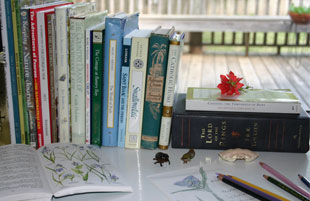| Author | |
LucyP
Forum All-Star

Joined: Aug 05 2007
Online Status: Offline
Posts: 791
|
| Posted: Nov 10 2007 at 3:14am | IP Logged
|
 |
|
Dear Ladies, I am only "allowed" online for "genuine research" and I guess this counts! We are starting our preparation for reception into the Church, and as I was never taught the ways of the faith as a child and as I am guessing (which may be unfair - we'll see) that our church will lay less emphasis on the forms and traditions than I would prefer I thought I'd ask here:
We want our faith to be beautifully, reverently expressed, to express our joy in God's holiness and grace to us, and to strive with all our being to be saints and "worthy" of heaven. How can we do this? I already wear a head covering whenever I go into a church (and at home when I pray family prayers and rosary but not at other spontaneous times). We like to know when to cross ourselves, when to genuflect, how to treat statues etc.
I feel this isn't quite making sense. Hmmm, anyone kind of get what I mean?
|
| Back to Top |


|
| |
vmalott
Forum All-Star


Joined: Sept 15 2006
Location: Ohio
Online Status: Offline
Posts: 536
|
| Posted: Nov 10 2007 at 8:57am | IP Logged
|
 |
|
I totally get it! When my husband was going through RCIA, he found a book called Why Do Catholics Do That? that I found enlightening, having been raised Catholic without really understanding why we do the things we do.
There is another book that is similar to this: Catholicism For Dummies, by Rev. John Trigilio (from EWTN). Despire the "for dummies" title, I've head that this is quite a good book.
There are certain traditions that people either aren't taught anymore, or don't care to practice, or whatever. An example: crossing yourself when passing by a church. Why? Because that is where Jesus, reserved in the Blessed Sacrament, resides.
We genuflect to the Tabernacle, where Jesus is. Not everyone was taught this, apparently, and it's kind of odd in newer churches (where there is a separate room for the Blessed Sacrament) to see people genuflect to the altar out of habit of genuflecting before sitting in the pew. You bow to the altar. 
There are a bunch of things regarding how to treat sacramentals, blessed items, etc. It's nice to have a handbook to know how to treat things with reverence. There's the tradition during Lent to "shroud" religious statues. Again, this isn't something everyone does, but it is a tradition, and it adds a nice dimension to celebrating the faith in your home.
Valerie
__________________
Valerie
Mom to Julia ('94), John ('96), Lizzy ('98), Connor ('01), Drew ('02), Cate ('04), Aidan ('08) and three saints in heaven
Seven Times the Fun
|
| Back to Top |



|
| |
MaryM
Board Moderator


Joined: Feb 11 2005
Location: Colorado
Online Status: Offline
Posts: 13104
|
| Posted: Nov 10 2007 at 11:00am | IP Logged
|
 |
|
LucyP wrote:
| We want our faith to be beautifully, reverently expressed, to express our joy in God's holiness and grace to us, and to strive with all our being to be saints and "worthy" of heaven. |
|
|
This is beautifully expressed and makes perfect sense, Lucy. And we are happy to help with guidance, just as we would teach any new member of our family.
Quote:
| We like to know when to cross ourselves, when to genuflect, how to treat statues etc. |
|
|
Genuflecting and bowing(from the Catholics United for the Faith tract)
In general, reverence is an outward expression performed in the presence of something or someone holy or sacred. In the Mass, reverence can be expressed in a number of ways. One way, for example, is bowing, either at the head or at the waist. This is sometimes done towards the altar or when the names of Jesus or Mary are said during Mass (GIRM, no. 275; CB, no. 68). Then there is genuflection, made by bending one’s right knee to the ground. Genuflecting expresses adoration and is therefore reserved for Our Lord in the Blessed Sacrament. The only exception is venerating the holy cross from Good Friday services until the beginning of the Easter Vigil (CB, nos. 69-71).
For example genuflecting when in front of the tabernacle or the monstrance in adoration.
Sign of the Cross
From the Catechism of the Catholic Church: The Christian begins his day, his prayers, and his activities with the sign of the cross: “in the name of the Father and of the Son and of the Holy Spirit. Amen.” The baptized person dedicates the day to the glory of God and calls on the Savior’s grace which lets him act as a child of the Father. The sign of the cross strengthens us in temptations and difficulties (no. 2157).
CUF has a tract on The Sign of the Cross though it might not have enough of the "when" you are looking for.
Basically since the Sign of the Cross is a prayer it can be prayed anytime or place. Specifcally in churches you will see people cross themselves when entering the church and dipping their fingers in the holy water font. This is a renewal of our baptismal promises. Other times you commonly see people make the sign of the cross: at the beginning and ending of a prayer, when genuflecting, after receiving Holy Communion.
Bert Ghezzi has written a book called Sign of the Cross: Recovering the Power of the Ancient Prayer. There is a short interview with him here.
Sign of the Cross article from Catholic Answer's This Rock.
__________________
Mary M. in Denver
Our Domestic Church
|
| Back to Top |



|
| |
Kathryn UK
Forum All-Star


Joined: Feb 27 2005
Location: England
Online Status: Offline
Posts: 924
|
| Posted: Nov 10 2007 at 12:47pm | IP Logged
|
 |
|
Lucy, this little book for young children explains a number of Catholic practices: Little Acts of Grace. I think you would like it for your little ones.
__________________
Kathryn
Dh Michael,  Rachel(3/95) Rachel(3/95)  Hannah(8/98) Hannah(8/98)  Naomi(6/06) Naomi(6/06)  (11/07) (11/07)
The Bookworm
|
| Back to Top |


|
| |
SusanJ
Forum All-Star


Joined: May 25 2007
Location: New Jersey
Online Status: Offline
Posts: 1347
|
| Posted: Nov 10 2007 at 8:23pm | IP Logged
|
 |
|
I've heard good things about Catholicism for Dummies, too.
It's really too bad that more RCIA classes don't teach you all the little things. The "doing" of Catholicism. It's all meaningless without the belief, of course, but the actions are important in and of themselves. I think you are really getting at one of the most important realities of the Catholic faith in your concern to be bodily, physically living and expressing your faith.
A book I really loved during my "reversion" to the Church was On Being Catholic by Thomas Howard. I have a special place for Tom Howard as he was fired from my alma mater after converting (long before my time). He was personally instrumental in my return to the Church. He's an English professor and his writing style is very bookish and literary but I think you will really love his focus on the "being Catholic."
It's not a guide to how to actually do everything but I think it will help connect everything for you.
God Bless,
Susan
__________________
Mom to Joseph-8, Margaret-6, William-4, Gregory-2, and new little one due 11/1
Life Together
[URL=http://thejohnstonkids.blogspot.com]The Kids' Blog[/UR
|
| Back to Top |



|
| |
|
|


 Topic: Ideas for a beautiful faith practise?
Topic: Ideas for a beautiful faith practise?







 Rachel(3/95)
Rachel(3/95)  (11/07)
(11/07)

